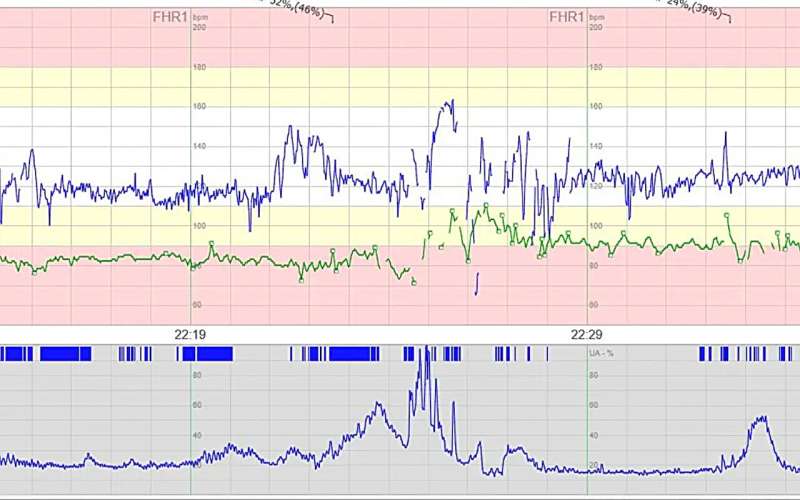This article has been reviewed according to Science X's editorial process and policies. Editors have highlighted the following attributes while ensuring the content's credibility:
fact-checked
peer-reviewed publication
trusted source
proofread
Study finds maternal pulse recording during childbirth reduces risk of encephalopathy in newborns

Cardiotocography (CTG) refers to the electronic recording of the fetal heart rate and uterine contractions. Fetal heart rate recorded through the mother's abdomen is the most commonly used fetal monitoring method during childbirth.
Now, a research team from the University of Helsinki and Helsinki University Hospital (HUS) has found that external fetal heart rate monitoring without simultaneous maternal pulse recording is associated with both an increased risk of neonatal encephalopathy and acidemia in fetal umbilical artery blood, i.e., critically low pH and base excess concentrations. Acidemia increases the need for newborn resuscitation and the length of intensive care.
The study, published in the American Journal of Obstetrics and Gynecology, analyzed almost 214,000 spontaneous full-term births in HUS maternity hospitals between 2005 and 2023. The study included the largest CTG dataset ever published.
The study demonstrated that a newborn monitored during labor with external fetal heart rate monitoring alone had a 1.6-fold risk of neonatal encephalopathy and a 2.3-fold risk of severe umbilical cord blood acidemia compared to those monitored with an internal electrode attached to the skin of the fetal head (internal monitoring) or by concurrent external fetal heart rate monitoring and maternal pulse recording.
"Especially during the second stage of labor, when mothers tend to display increased heart rate while pushing, fetuses more commonly exhibit heart rate decelerations. Consequently, the fetal heart rate can be quite easily mixed with the maternal pulse, in which case abnormal fetal heart rate tracing, indicating fetal hypoxia, may go unnoticed by professionals," says Researcher Mikko Tarvonen, describing the challenges of external CTG monitoring.
In the majority of the labors in the study (38%), solely external monitoring was used. Internal monitoring was the second most common method (33%), followed by external monitoring simultaneously with maternal pulse recording (29%).
Years of safer practice at HUS
The world's largest organizations of obstetricians and midwives recommend in their fetal monitoring guidelines that external fetal heart rate monitoring be used as the primary CTG registration method. However, the new study indicates that, without simultaneous maternal pulse recording, this method is a significant risk factor predisposing the fetus to labor-related hypoxia and its long-term neurological effects.
"Based on our results, this tragedy can be effectively prevented by combining maternal pulse recording with fetal heart rate monitoring. This method allows professionals to be sure of whose heart rate they are monitoring," says Tarvonen.
In 2019 HUS adopted a new protocol emphasizing the necessity of recording maternal heart rate alongside fetal heart rate during childbirth.
"Practices have long varied at Finnish maternity hospitals, but training and research evidence have resulted in a shift in attitudes and thus the increased use in recent years of maternal pulse monitoring," Tarvonen notes.
The present study demonstrated that, based on the incidence of neonatal encephalopathy, external fetal heart rate monitoring combined with maternal heart rate recording is equally as safe as internal fetal monitoring. However, internal monitoring was the most accurate way of assessing fetal well-being. Its use was associated with the lowest incidence of hypoxia-related neonatal outcomes.
The incidence of both neonatal encephalopathy and severe umbilical artery blood acidemia has decreased significantly in the HUS region during the study's 18-year follow-up period.
"This trend is exceptional even by international standards," Tarvonen points out.
More information: Mikko Tarvonen et al, Intrapartum cardiotocography with simultaneous maternal heart rate registration improves neonatal outcome, American Journal of Obstetrics and Gynecology (2024). DOI: 10.1016/j.ajog.2024.01.011





















